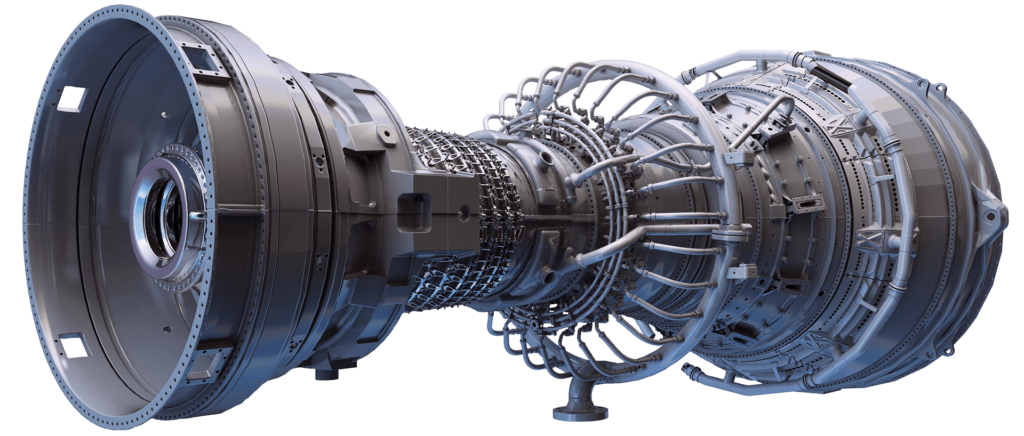In the quest for more efficient and environmentally friendly power generation, aero-derivative turbine have emerged as a vital component in modern combined cycle power plants. These turbines, derived from jet engine technology, offer numerous advantages that enhance the performance and sustainability of power plants. This blog explores the integration of aero-derivative turbines with combined cycle systems, their benefits, and notable examples of successful installations.
Integration with Combined Cycle Systems
A combined cycle power plant (CCPP) integrates both gas and steam turbines to maximize efficiency. In this system, aero-derivative turbine play a crucial role as the gas turbine component. The process begins with the gas turbine, which burns fuel to produce high-temperature, high-pressure exhaust gases. These gases drive the turbine blades, generating mechanical energy that is converted into electrical power.
The exhaust gases from the gas turbine are then directed to a heat recovery steam generator (HRSG), which captures the waste heat and converts it into steam. This steam drives a steam turbine, which generates additional electricity. The integration of aero-derivative turbines into this cycle allows power plants to utilize the waste heat more effectively, improving overall efficiency and reducing fuel consumption.
Benefits for Efficiency and Emissions Reduction
Aero-derivative turbine offer several benefits that significantly impact the efficiency and environmental performance of combined cycle power plants:
High Efficiency: Aero-derivative turbines are designed for high-performance applications, with high thermal efficiency and quick start-up capabilities. Their advanced technology allows them to operate efficiently across a range of loads, making them ideal for combined cycle systems where maximizing efficiency is crucial.
Lower Emissions: By improving efficiency, aero-derivative turbines contribute to lower greenhouse gas emissions. The enhanced combustion process and reduced fuel consumption result in fewer emissions per unit of electricity generated. This is particularly important for meeting stringent environmental regulations and reducing the carbon footprint of power plants.
Flexibility and Reliability: Aero-derivative turbine are known for their flexibility and reliability. They can quickly adjust to changes in power demand, making them well-suited for combined cycle plants that need to balance base load and peak load requirements. Their robust design ensures consistent performance and minimal downtime, further enhancing the overall efficiency of the power plant.
Examples of Successful Installations
Several power plants worldwide have successfully integrated aero-derivative turbines into their combined cycle systems, demonstrating their effectiveness and advantages:
The Alstom Combined Cycle Power Plant, Dubai: This facility utilizes aero-derivative gas turbines to achieve high efficiency and reliability. The integration of these turbines with the combined cycle system has enabled the plant to meet Dubai’s growing energy demands while adhering to stringent environmental standards.
The Siemens Combined Cycle Power Plant, Texas: Featuring Siemens’ advanced aero-derivative turbines, this plant showcases the benefits of high efficiency and lower emissions. The plant’s successful operation highlights the effectiveness of aero-derivative turbines in achieving both economic and environmental goals.
The GE Combined Cycle Power Plant, Qatar: This installation demonstrates the flexibility and performance of GE’s aero-derivative turbines in a combined cycle system. The plant’s ability to efficiently handle varying loads and reduce emissions underscores the advantages of using these turbines in modern power generation.
Technological Advancements in Aero-Derivative Turbines
Aero-derivative turbines have evolved significantly over the years, incorporating cutting-edge technologies that enhance their performance and efficiency. The use of high-temperature, lightweight materials improves the durability and efficiency of aero-derivative turbines. These materials can withstand extreme conditions, allowing turbines to operate at higher temperatures and pressures, which enhances overall performance.
Modern aero-derivative turbines feature advanced combustion systems that improve fuel efficiency and reduce emissions. Technologies such as dry low NOx (DLN) burners ensure cleaner combustion by minimizing nitrogen oxide emissions, which is crucial for meeting regulatory standards.
The integration of digital controls and advanced monitoring systems enables precise management of turbine operations. Real-time data collection and analysis facilitate predictive maintenance, optimize performance, and ensure operational reliability.
Economic Implications of Aero-Derivative Turbines
Incorporating aero-derivative turbines into combined cycle power plants also has several economic implications:
- While the initial investment in aero-derivative turbines may be higher compared to traditional gas turbines, their high efficiency and low maintenance requirements can lead to significant long-term cost savings. The reduced fuel consumption and extended service intervals contribute to lower operating costs.
- The enhanced efficiency and reliability of aero-derivative turbines can result in a favorable return on investment. By generating more electricity from the same amount of fuel and minimizing downtime, power plants can achieve higher revenue and better financial performance.
- Power plants equipped with aero-derivative turbines can offer competitive advantages in the energy market. Their ability to provide reliable and efficient power generation can attract customers and secure long-term contracts, contributing to market success.
Turbine control system
Turbine control systems are essential for managing the operation of turbines in power plants, ensuring optimal performance, safety, and efficiency. These systems consist of several key components: the control unit, which processes data from sensors and makes real-time decisions; sensors that monitor critical parameters like temperature, pressure, and speed; and actuators that adjust physical components such as valves and blades. The control unit uses algorithms and control strategies to balance performance and safety, making real-time adjustments based on sensor data. By integrating these components, turbine control systems help optimize turbine operation, enhance reliability, and reduce the risk of operational issues, playing a crucial role in the efficient and safe generation of power. IS200HFPAG2A, and IS200EGPAG1BEC are some examples of GE turbine control system spare components.
Conclusion
Aero-derivative turbines play a pivotal role in modern combined cycle power plants by enhancing efficiency, reducing emissions, and providing reliable performance. Their integration into combined cycle systems allows power plants to maximize energy output while minimizing environmental impact. As technology continues to evolve, the role of aero-derivative turbines in achieving sustainable and efficient power generation will only become more significant, shaping the future of energy production worldwide.
Also read:







More Stories
Rise of Artificial Intelligence: Revolution
Exploring the Ethical Implications of AI
Domestic Surveillance Investigation LA County